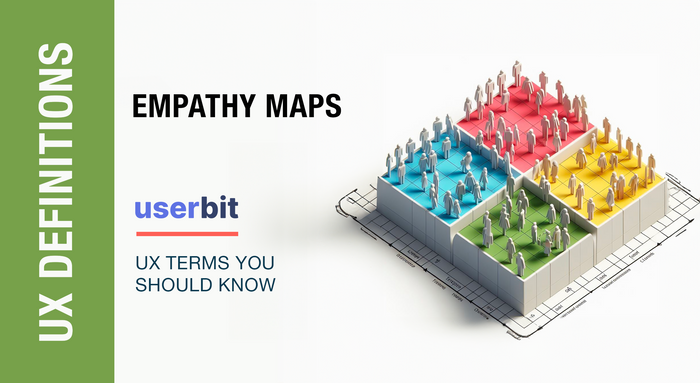
Empathy Mapping for UX Professionals
Do you ever wish you could just get inside of your users’ minds? Well, we’ve gotchu. We’re not mind readers, but we do have a method we’re happy to share!
Let’s take a look below at empathy mapping and how an empathy map can help you get on the same page with whoever you’re working with and also create a deep understanding of your end users
What is empathy mapping?
Empathy mapping is a simple yet profound tool used in UX design to gain deeper insights into your users' thoughts, feelings, actions, and environment.
You can think of it as a collaborative method that’s meant to create a shared understanding among teams about their users.
At its core, empathy mapping looks like a grid that’s divided into four quadrants, with each one representing a critical aspect of your user's experience: Says, Thinks, Does, and Feels.
These 4 sections are here to assist UX professionals with stepping into their users' shoes so you’ll get a multi-dimensional view of their experiences, and they’re also great for fostering a shared understanding and clearer focus among team members.
They’re particularly effective when employed early in the design process to help teams align on user needs and prioritize them effectively, but you can create them at any point in the product development lifecycle.
Format of an empathy map
Empathy maps are typically organized into four distinct sections that have a central focus on the user or a specific persona.
These maps offer a snapshot of a user's identity and experiences, without necessarily following a chronological or step-by-step progression.
1. Says
In the "Says" quadrant, you capture the user's spoken words during a UX interview or usability test. This quadrant should ideally contain exact quotes from the user. For example:
"I find this app's navigation really intuitive."
"The checkout process is too long and complicated."
"I'm not sure where to find the settings in this user interface."
2. Thinks
The "Thinks" quadrant focuses on the user's internal thoughts during their experience with a product. These are insights you infer from user behavior or expressions during research. This quadrant might reveal:
"I hope this doesn't take too much time."
"I'm not sure if my data is secure with this app."
"This feature seems unnecessary."
3. Does
In the "Does" quadrant, you document the user's actions. This is what you observe them doing during usability tests or from their usage data. Some examples include:
- frequently switching between tabs to find information
- using the search function instead of navigating through menus
- zooming in on images or text for a clearer view
4. Feels
The "Feels" quadrant is about the user's emotional responses. Here you note emotions inferred from their expressions, tone of voice, or feedback. For example:
- Frustrated: unable to complete a task quickly.
- Delighted: when a feature works seamlessly.
- Anxious: about making a mistake during a critical task.
What about across all quadrants?
Keep in mind that users are complex, and their experiences often span across multiple quadrants, so don’t be surprised if you find out that there are contradictions in your empathy map, like positive actions accompanied by negative feedback.
These discrepancies are valuable for a deeper understanding of user needs and behaviors.
For instance, a user might express satisfaction with a product's features (Says), yet internally feel overwhelmed by the choices (Thinks), exhibit hesitation in using certain functions (Does), and feel anxious about making the right selections (Feels).
So when filling out the quadrants, don't worry too much about perfect precision. Sometimes, insights could fit into multiple sections.
Just remember your main goal, which is to cover all essential aspects of the user's experience. If a quadrant seems empty or sparse, it might indicate a need for more comprehensive user research.
How to create an empathy map
Making an effective empathy map involves a structured approach. Don’t worry, we have you covered. Here's a quick-n-easy explanation of the process:
1. Define your scope and objectives
First you’ll want to identify whether you’re mapping for an individual user or a persona. We recommend sticking one user or persona per map to lessen confusion!
2. Establish your purpose
Now, you’ll want to decide the main goal of your empathy mapping session.
For example, if it's team alignment, then make sure your full team can participate.
If it's to analyze research, set boundaries and time limits so you can efficiently cover multiple interviews.
3. Gathering the necessary materials
The next step is to choose tools based on your mapping context.
To make it fun and collaborative for team sessions, you can use a large whiteboard, sticky notes, and markers. For solo mapping, select a method that's easily shareable with your team, like creating a visual map with a sendable link.
4.Collect the research data
Why hello…here comes our favorite part as Userbitters.😉
For this part, you’ll want to compile qualitative data such as user interviews, field studies, diary studies, listening sessions, or qualitative surveys, which will form the basis of your empathy map.
5. Create quadrant-specific notes
With your research data at hand, individually create notes for each of the four quadrants. Then, as a team, add these notes to the mapped quadrants on a whiteboard.
6.Group and synthesize the information
This step involves working collaboratively with your team (or on your own if you’re solo) to cluster similar notes within each quadrant. Label these clusters with thematic titles which will be crucial for fostering team discussions and achieving a unified understanding of your user.
7.Refine and plan your next course of action
Now it’s time to customize your empathy map to fit specific needs by adding extra quadrants or details. Here, you’ll finalize and digitize the map for broader use.
Remember to include details about the user, outstanding questions, and the date/version of the map. You can always revisit and update your empathy map as new research becomes available or to guide future UX decisions.
How UserBit can help
Need a hand during your future empathy mapping sessions?
UserBit offers features for organizing and analyzing qualitative user research so it’s easier to fill in and understand each quadrant of your empathy map.
With its collaborative features, teams can work together seamlessly to ensure that every design decision is grounded in a deep understanding of the user.
You can leverage UserBit to enhance the entire process — from note taking to creating relevant journey maps and generating insights that’ll make your product better than ever.


